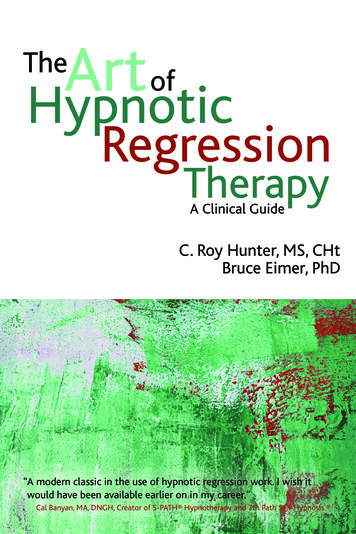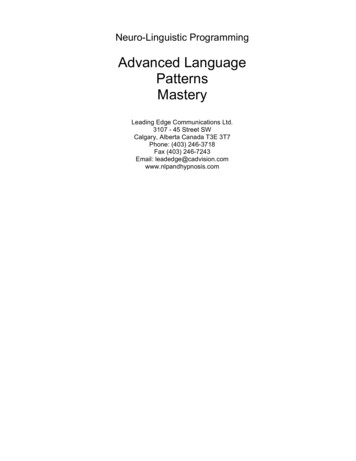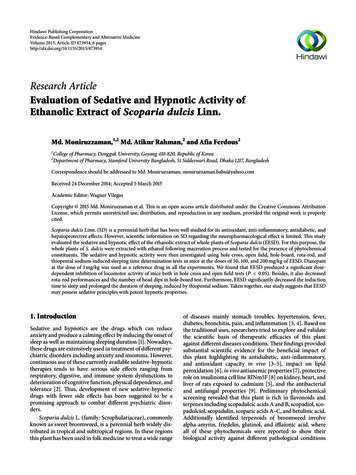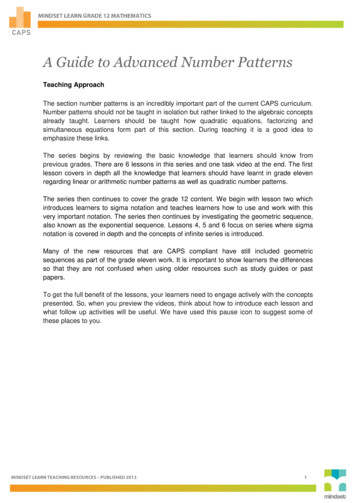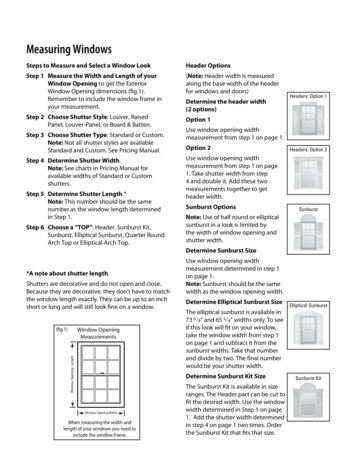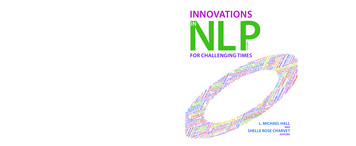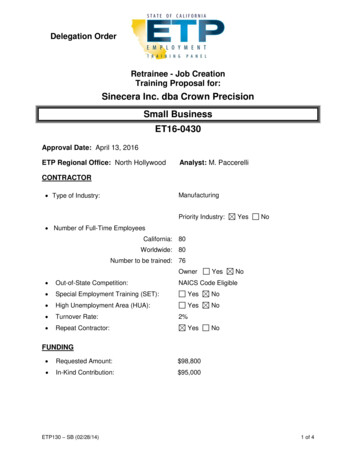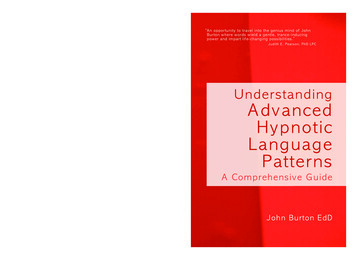
Transcription
Burton shows therapists how to expand their clients’ cognitive awareness,specifically the cognitive and perceptual processes involved in meaning making. Bydoing so, therapists are more able to identify the specific awareness limitations ofeach of their clients and identify the specific cognitive perceptual ingredients thatmake up that client’s problem. Drawing on this insight, therapists can then constructhypnotic language patterns that go right to the client’s issues, invoking positivechange. Numerous case examples are presented that include client assessments anddynamics, selecting and constructing hypnotic language patterns and applying thelanguage patterns in therapy.“Dr. Burton’s conceptualization that our perceptions bind our awareness to the resources orproblems we find real in our daily life, is a brilliantly written and much-needed contribution tothe field. His contribution regarding how we chunk and categorize experience is pragmaticallyuseful to all therapists. I think every psychotherapist should read this book and learn how theycan advance the field of therapy by applying its concepts.”Stephen Lankton, MSW, DCSW, DAHB“This is a fascinating book - and more helpful and interesting than the title would suggest.While not all the ideas are entirely new, it is the first time I have seen them put together in onevolume in such an interesting and readable way. I am convinced that this book will be of realbenefit to all hypnotherapists - from the newly qualified to the practitioner with several years’experience.”Ursula Markham, Founder of the Hypnothink Foundation“Understanding Advanced Hypnotic Language Patterns is an opportunity to travel into thegenius mind of John Burton where words wield a gentle, trance-inducing power and impartlife-changing possibilities.”Dr John Burton holds a Doctorate in Human Development Counseling and a Master’sDegree in Clinical Psychology. He is licensed as both a Professional Counselor andSupervisor as well as being a certified Master Practitioner of Neuro-Linguistic Programming.Dr Burton has over fifteen years’ experience as a psychotherapist and currently runs hisown private practice, “Educare Counseling”. He also teaches psychology on a part-timebasis at a local college in addition to conducting personal-growth workshops.HypnotherapyISBN Crown House Publishing Limitedwww.crownhouse.co.ukwww.chpus.com9 7 81 845 9003 2 8John Burton EdDJudith E. Pearson, PhD LPCUnderstanding Advanced HypnoticLanguage Patterns A Comprehensive GuideIn this long awaited follow-up to John Burton’s best-selling Hypnotic Language hegoes into the subject in greater depth and also elaborates more on the concepts thatcomprise hypnotic language. The core idea presented is that a person’s level ofcognitive awareness significantly determines his functioning ability in life.“An opportunity to travel into the genius mind of JohnBurton where words wield a gentle, trance-inducingpower and impart life-changing possibilities.”Judith E. Pearson, PhD LPCUnderstandingAdvancedHypnoticLanguagePatternsA Comprehensive GuideJohn Burton EdD
Understanding Advanced Prelims:Understanding Advanced Hypnotic Language PatternsUnderstandingAdvanced HypnoticLanguage PatternsA Comprehensive GuideJohn Burton, EdDCrown House Publishing :3
Understanding Advanced Prelims:Understanding Advanced Hypnotic Language PatternsFirst published byCrown House Publishing LtdCrown Buildings, Bancyfelin, Carmarthen, Wales, SA33 5ND, UKwww.crownhouse.co.ukandCrown House Publishing Ltd6 Trowbridge Drive, Suite 5, Bethel, CT 06801-2858, USAwww.chpus.com John Burton, EdD 2007The right of John Burton to be identified as the author of this work hasbeen asserted by him in accordance wih the Copyright, Designs andPatents Act 1988.All rights reserved. Except as permitted under currentlegislation no part of this work may be photocopied, stored in a retrievalsystem, published, performed in public, adapted, broadcast, transmitted,recorded or reproduced in any form or by any means, without the priorpermission of the copyright owners. Enquiries should be addressed toCrown House Publishing Limited.British Library of Cataloguing-in-Publication DataA catalogue entry for this book is availablefrom the British Library.10-Digit ISBN: 184590032413-Digit ISBN 978-1845900328LCCN 200693487617/11/0609:3
Understanding Advanced Prelims:Understanding Advanced Hypnotic Language PatternsContentsIntroductionHypnotic Language: A Cognitive–DevelopmentalApproach .1Chapter 1Categorizing Data: The Continuum of Awareness .7Chapter 2Gestalt Categories of Framing .25Chapter 3Cognitive Styles Identified by Piaget .43Chapter 4Hypnotic Language Scripts Addressing EmotionalStates .65Chapter 5Hypnotic Language Scripts Addressing Perception .89Chapter 6Hypnotic Language Scripts Addressing Time .139Chapter 7Hypnotic Language Scripts Addressing Behavior .151Chapter 8Hypnotic Language Script Addressing SmokingCessation .187AppendixThe Milton Model: Hypnotic Language Patterns .203Bibliography.223i17/11/0609:3
Understanding Advanced p1-:Understanding Advanced Hypnotic Language Patterns16/11/06IntroductionHypnotic Language:A Cognitive–DevelopmentalApproachIn this work, we will explore hypnotic language through severalperspectives. The primary emphasis will come from a cognitivepoint of view. This cognitive view includes thinking styles andhuman development levels, as well as levels of perception. And justwhat is hypnotic language, you may ask. Hypnotic languageinvolves structuring sentences in such a way as to invite the readeror listener into a trance state. Here we will define a trance state asbeing a heightened state of focus or concentration on a single itemor group of like items to the exclusion of all other items.The principal purpose of hypnotic language, according to thiswork, is to assist clients into a trance for the purposes of examiningthe contents of a particular focus, allowing the clients to then adjustthe contents, meaning, and influence in their life. The developmentand study of hypnotic language stems primarily from the work ofMilton Erickson, MD. My hope is that this present work will add tothe understanding of the structure and therapeutic applications ofhypnotic language.Hypnotic language could be thought of as taking three generalforms. The first form addresses the cognitive aspects of a person’sexperience. This includes rather directly accessing cognitive styles,including the developmental and perceptual ingredients that createone’s experience. In essence, this form of hypnotic languageattempts to restructure an individual’s experience and the meaningattached to the experience. Addressing cognitive aspects of one’sexperience amounts to reframing by dismantling and reconstructing the ingredients making up the frame that sets the experience.The second form of hypnotic language might be thought of asmetaphorical forms of communicating with the unconscious mind.11:59P
Understanding Advanced p1-:Understanding Advanced Hypnotic Language Patterns16/11/06Understanding Advanced Hypnotic Language PatternsThis communication is offered to the client while they are in a moreformal trance. The method of change here occurs through helpingthe client recategorize experiences. This also becomes reframing.But a different path to reframing is taken in this second form. Whilethe cognitive approach addresses the parts that make up the frame,the metaphorical path works by addressing the frame as a whole,and then moving the contents into another frame to create newmeaning.By way of a metaphor to distinguish between these two hypnoticlanguage forms: sometimes people remodel their house, giving it awhole new feel, whilst sometimes in order to give it a whole newfeel, people move their entire house to a new location.A third type of hypnotic language works by bringing a needed butmissing resource to the situation, bringing the mountain toMohammed, so to speak. This third style of hypnotic languageassists personal change by introducing awareness of new resourcesinto an existing frame. Once introduced and integrated, the newresource then creates a whole new frame and eventually a differentemotional-behavioral outcome. The avenue for introducing thisnew resource is also a metaphorical one, presented while the clientis in some degree of trance.The first section of this book presents a model that describes howwe cognitively process information. We’ll use this model to explainthe layers and stages of information processing. This four-tierhierarchy of information processing will also serve to identify thecognitive targets of hypnotic language.Now we will move to describing the four-tier structure involved incognitive processing of information. These four tiers will be discussed in more detail in subsequent chapters. But for now, here is ageneral thumbnail sketch of each tier and its role. The first tier ofthis four-tier system comes into play when we experience a stimulus. Initially, we receive information through one or more of our fivesenses. This information may come from observing or interactingwith external sources. We may also receive information throughinternal sources such as bodily sensations. This informationreceived from one or more of our senses sends signals to our brainand the information is subjected to the dynamics of the first tier ofthe hierarchy.211:59P
Understanding Advanced p1-:Understanding Advanced Hypnotic Language Patterns16/11/06IntroductionThe first tier of the information-processing system is referred tohere as the continuum of awareness. The continuum of awarenessconsists of levels of awareness based on the amount of comparativeinformation we use when assessing a stimulus. This continuumdetermines the general frame size we notice. This general frame ismade up of the available information to use when comparing, contrasting, and then processing the new stimulus into a meaningfulsubset of a whole.The second tier of this meaning-making process involves puttingthe sorted information together into some organized meaning inrelation to other parts, somewhat like assembling a jigsaw puzzle.Frames or categories of information are created here. I use the termsframes and categories as having the same meaning in this work.This information-assembling process involves Gestalt psychologycategories of frame making or categorizing information. We assemble initially random pieces of information into some meaningful,relatively sensible whole by using the parts of the puzzle. It isinteresting to note that the available parts of the puzzle stem fromthe level of awareness within the continuum of awareness, and theperceptual-cognitive level of development used when sortingthe information. This meaning-making event is an interaction effectbetween the perceptual-cognitive level of development and Gestaltframing mechanisms.The third tier consists of processes that attempt to make more personal meaning of the information received through our senses(Keagan, 1983). This process consists of sorting the received information through one of several perceptual and cognitive levels ofdevelopment (Piaget, 1965). To a great extent, the perceptual-cognitive level through which the information is sorted determines itspotential meaning in our lives. This potential meaning ranges fromself-limiting beliefs to unlimited possibilities for success. Once theinformation received gets identified, a function of our perceptualcognitive-developmental level, we send the labeled pieces to thenext tier of the hierarchy for further meaningful assembly.To give an example that may help solidify these first three levels ofperceptual-cognitive development concepts, imagine walking intoa clothing store. You decide to sort through the collection of clothing for red shirts. You filter out all other shirts as well as all other311:59P
Understanding Advanced p1-:Understanding Advanced Hypnotic Language Patterns16/11/06Chapter 3Cognitive Styles Identifiedby PiagetThis section presents the third tier of the four-tier information-processing system. In Hypnotic Language: Its Structure and Use (Burtonand Bodenhamer, 2000) the work of Jean Piaget was drawn onextensively. Piaget’s groundbreaking work, refined by research thatfollowed, revealed the cognitive styles that children use in processing information in their world. These same cognitive styles prominent in childhood are also used by adults at times. It seems thatpersonal trauma experienced in childhood increases the likelihoodof utilizing the cognitive styles of childhood.These thinking styles also often surface during times of emotionalintensity in adulthood, without prior emotional trauma. It appearsthat our mental focus narrows, perhaps instinctively, during timesof emotional intensity. Maybe at some level this serves as a selfpreservation mechanism. Regardless of the potential benefits atcertain times, the cognitive processing styles that are inevitable inchildhood play a significant role in the structure of personalproblems. The inverse of these cognitive processes, expandingawareness, plays a significant role in solving personal problems. Asyou will see, hypnotic language addresses and reverses limitingstyles of thinking.Below is a list and description of cognitive styles, followed by aseries of questions that you can ask of your clients that may helpfurther elicit the presence of a cognitive style and its influence in aclient’s problem. Each cogn
Chapter 5 Hypnotic Language Scripts Addressing Perception .89 Chapter 6 Hypnotic Language Scripts Addressing Time .139 Chapter . But a different path to reframing is taken in this second form. While the cognitive approach addresses the parts that make up the frame, the metaphorical path works by addressing the frame as a whole, and then moving the contents into another frame to .

